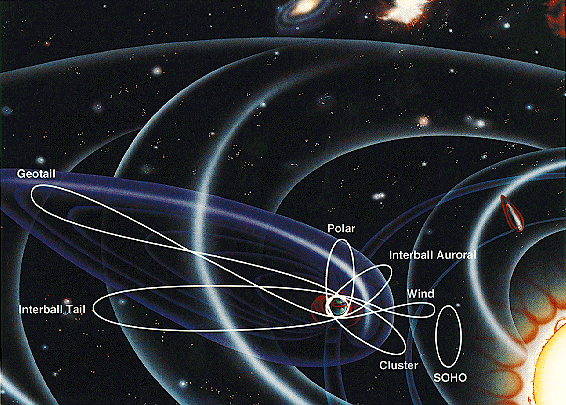

The Tail Probe is launched to an orbit with a low angle with the ecliptic plane to reach high altitude cusp and subsolar magnetopause regions on the dayside and then, the neutral sheet in the nightside tail.
The Auroral Probe orbit is optimised for the magnetic conjunctions between the two pairs of satellites around the midnight meridian. This will allow to study the cause-and-effect relationships between the plasma processes in the tail and in the auroral particles acceleration region above the auroral oval with a high time-space resolution. In the other phase of the Project various solar wind disturbances and X-ray emission bursts on the Sun will be studied from the Tail Probe together with their effects on the cusp-cleft and other regions of the dayside magnetosphere and ionosphere measured simultaneously by the Auroral Probe. This again will allow to observe and analyse the cause-and-effect relationships in the solar wind/magnetosphere interactions.
These cause-and-effect relationships are very important to understand as they are related to the most powerful non-linear plasma processes around the planet Earth producing strong electric currents in magnetosphere and ionosphere: the magnetic storms, accelerated particle beams, auroral phenomena, radio-wave emissions and variations in the neutral atmosphere. Similar processes are known to exist in the magnetospheres of other planets of the Solar System and most probably around pulsars and other astrophysical objects. They are due to large- and small-scale plasma physical processes which are difficult, or sometimes impossible to study in laboratory plasma devices.
At the same time, magnetic storms lead to disturbances, especially at high latitudes, in radio-wave propagation, noises in telephone lines, global positioning systems and can even block the radars in the meter wave-length range by strong auroral reflections. But the most dangerous could be strong quasi-DC currents induced in the large-scale power line systems in the Arctic by rapid magnetic field variations during a magnetic storm burst.
The danger of switching off a power system is quite real, and such catastrophic cases have already occurred (for example, on March 13, 1989 in Quebec, Canada). The rapid industrial development of polar regions of Russia and other countries makes it necessary to improve drastically the methods and quality of the substorm predictions to use in the short-time control operations. Obviously for that the deep understanding is necessary of the relevant plasma processes generating the magnetospheric currents and controlling their bursts.
This means that for Russia as well as for other countries having the territories in the polar regions the studies of the solar-terrestrial plasma processes are not only an important scientific problem, but it is also a vital practical need.
The INTERBALL project involves the efforts of a large international community of Russia together with Austria, Bulgaria, Canada, Czech Republic, European Space Agency (ESA), Finland, France, Germany, Hungary, Italy, Kirgizia, Poland, Romania, Slovakia, Sweden, United Kingdom and Ukraine. Besides that a close cooperation within the project with the ground-based geophysical observations community will allow a timely information on the current solar and geophysical conditions which are indispensable to put the satellite data in the global solar-terrestrial perspective.

The INTERBALL project became an inherent part of the vast international cooperation within the IACG (Inter-Agency Consultative Group) with the other major space missions of the 1995-1996: GEOTAIL and WIND which are already launched, and POLAR, SOHO, FAST and RELICT-2 in preparation as well as expected in a near future some low altitude space missions.
Russian Space Agency, and its Babakin Space Center, made enormous efforts to complete the multy-point INTERBALL Project. Also, the contributions from other agencies, especially from the Czech Space Agency (formerly from Czecho-Slovakian Academy of Sciences), who made the two subsatellites, were indispensable. Some of them also rendered financial support for the preparation of the Project at various stages, apart from their instruments development. While it is not possible to name all of them, I would like to express our deep gratitude for their contributions, for the cooperative spirit and mutual help which always dominated in our common work.
A.A.GALEEV, IKI director
 Back to the Interball Home Page
Back to the Interball Home Page